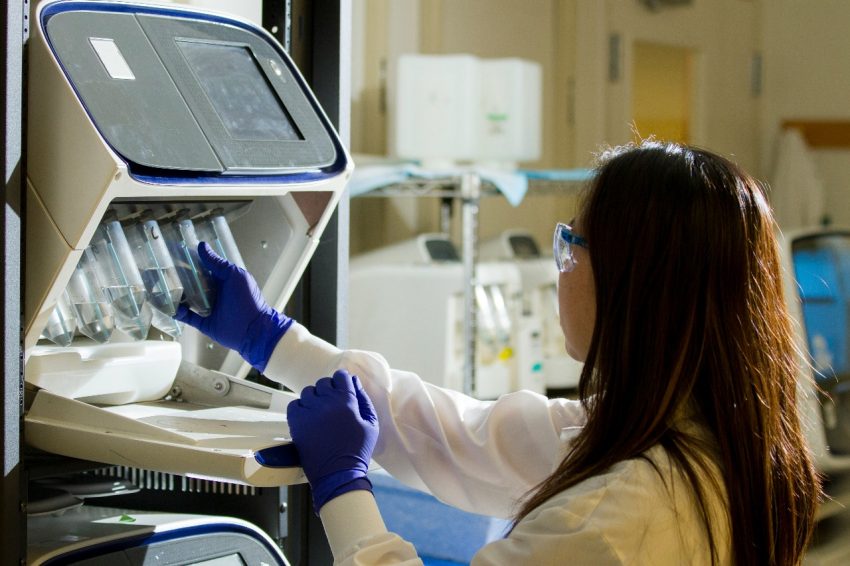GHRP-2 (Growth Hormone Releasing Peptide-2) and CJC-1295, a modified form of Growth Hormone Releasing Hormone (GHRH), represent two peptides with distinct yet potentially complementary biological properties. Studies suggest that GHRP-2 might have a significant impact on the stimulation of growth hormone (GH) release individually via its interaction with ghrelin receptors. At the same time, CJC-1295 is theorized to extend the half-life of endogenous growth hormone release through binding to GHRH receptors.
Their combined activity suggests a promising avenue for further research into the modulation of growth hormone pathways, with potential implications across a variety of scientific domains, including endocrinology, metabolic research, and regenerative studies. This article explores the proposed biochemical properties of these peptides, hypothesizes on their synergistic potential, and outlines their possible research implications.
Introduction
Peptides have emerged as key molecules in the exploration of biological processes, with potential implications across various fields, including molecular biology, tissue engineering, and metabolic regulation. GHRP-2 and CJC-1295 stand out for their hypothesized interactions with the growth hormone axis. This critical pathway regulates a multitude of biological functions, such as metabolism, growth, and cellular repair in organisms.
Biochemical Properties of GHRP-2
GHRP-2, a hexapeptide composed of six amino acids, is studied for its potential to interact with the ghrelin receptor (also referred to as the Growth Hormone Secretagogue Receptor, or GHS-R1a). Ghrelin often referred to as the “hunger hormone,” is predominantly produced in the stomach and plays a role in energy balance, appetite regulation, and growth hormone release. Studies suggest that GHRP-2 might mimic ghrelin’s impact by binding to its receptor, which in turn may lead to the stimulation of growth hormone secretion from the anterior pituitary gland.
Biochemical Properties of CJC-1295
CJC-1295 is a synthetic analog of Growth Hormone Releasing Hormone (GHRH), a peptide hypothesized to stimulate the release of GH from the pituitary gland. One of the defining features of CJC-1295 is its extended half-life compared to endogenous GHRH, attributed to its binding with albumin in the bloodstream. This modification may result in sustained stimulation of growth hormone release over a prolonged period, which contrasts with the more transient spikes in GH secretion typically induced by GHRP-2 alone.
Potential Synergy of GHRP-2 and CJC-1295
GHRP-2 and CJC-1295 are believed to hold significant promise for the modulation of growth hormone pathways. However, when combined, their synergistic potential becomes particularly intriguing. GHRP-2’s hypothesized role in stimulating acute GH release via ghrelin receptor activation might complement the longer-acting, sustained GH release associated with CJC-1295. This dual-phase stimulation might lead to a more consistent and prolonged modulation of the GH/IGF-1 axis, which may be of interest to researchers working in areas where both immediate and extended GH stimulation is desirable.
Research Implications in Metabolism
The potential for GHRP-2 and CJC-1295 to modulate growth hormone release suggests their possible implications in metabolic research. Growth hormone is thought to regulate metabolism, influencing processes such as lipolysis, glucose utilization, and insulin sensitivity by supporting the pulsatile release of GH. Research indicates that the GHRP-2/CJC-1295 blend might offer new insights into how fluctuations in growth hormone levels might impact overall energy balance and metabolic function.
Tissue and Cellular Processes
Another area of interest for the GHRP-2/CJC-1295 combination is tissue regeneration and cellular repair. Researchers believe that the growth hormone stimulates cellular proliferation and tissue repair through its downstream mediator, Insulin-like Growth Factor-1 (IGF-1). Investigations purport that GHRP-2 may trigger acute increases in GH, leading to transient spikes in IGF-1 levels, while CJC-1295 might maintain a more consistent elevation in IGF-1, providing extended periods of cellular stimulation.
Cellular Aging and Longevity Research
Findings imply that the GHRP-2/CJC-1295 blend might also have implications for cellular aging research, given the possible role of growth hormone in modulating cellular age-related processes. GH levels decline over time, contributing to a reduction in the lean mass of muscular tissue, increased adiposity, and a decrease in overall tissue repair capacity. By utilizing the combined impact of these peptides, researchers may gain insights into how growth hormone modulation may influence the cellular aging process and the maintenance of tissue integrity as cells and tissues succumb to the cellular aging process.
Conclusion
The combination of GHRP-2 and CJC-1295 presents a promising avenue for scientific exploration. It has the potential to impact a wide range of biological processes related to growth hormone modulation. From metabolic regulation to tissue repair and acellular ging research, these peptides have been hypothesized to offer a dynamic approach to investigating GH-dependent pathways.
While further research is required to fully elucidate their synergistic potential, the proposed properties of this peptide blend suggest its implications across diverse scientific domains, making it a valuable topic for ongoing and future investigations into peptide-based agents and biological modulation strategies. GHRP-2 and CJC 1295 blend is available at online to researchers interested in further studying the individual potential of these peptides as well as their synergistic capabilities.
References
[i] Ghigo, E., Arvat, E., & Gianotti, L. (2001). Growth hormone-releasing peptides. European Journal of Endocrinology, 144(1), 1-5. https://doi.org/10.1530/eje.0.1440001
[ii] Russell-Jones, D. (2004). CJC-1295, a long-acting growth hormone-releasing hormone analog: Progress and prospects. Therapeutics and Clinical Risk Management, 1(3), 173-179.
[iii] Hatzirodos, N., Irving-Rodgers, H. F., Hummitzsch, K., Harland, M. L., Morris, S. E., & Rodgers, R. J. (2014). Growth hormone and insulin-like growth factor 1 regulate human ovarian stromal cell function. Biology of Reproduction, 90(2), 21. https://doi.org/10.1095/biolreprod.113.113605
[iv] Muñoz-Moreno, C., Sáez, L., Jódar, E., & Hawkins, F. (2015). Growth hormone deficiency and aging. Endocrinología y Nutrición (English Edition), 62(1), 37-44. https://doi.org/10.1016/j.endonu.2014.11.002
[v] Wu, Z., Zeng, R., Zhou, Y., Yang, G., & Shi, B. (2016). Growth hormone receptor gene therapy for treating obesity and diabetes. Journal of Clinical Investigation, 126(8), 3045-3059. https://doi.org/10.1172/JCI86188














